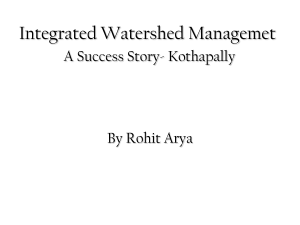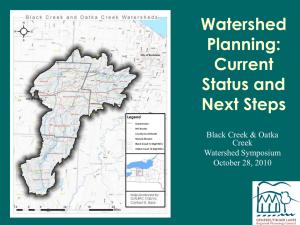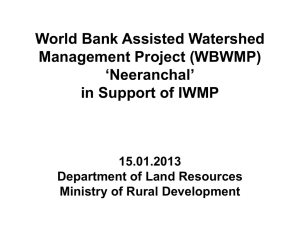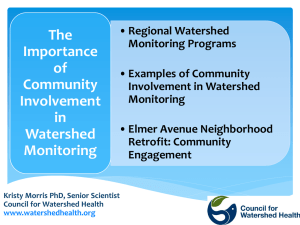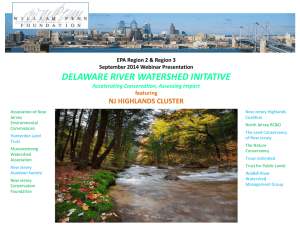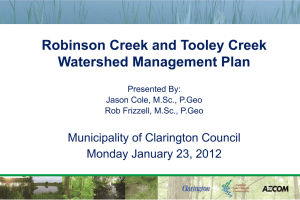objectives of watershed management
advertisement
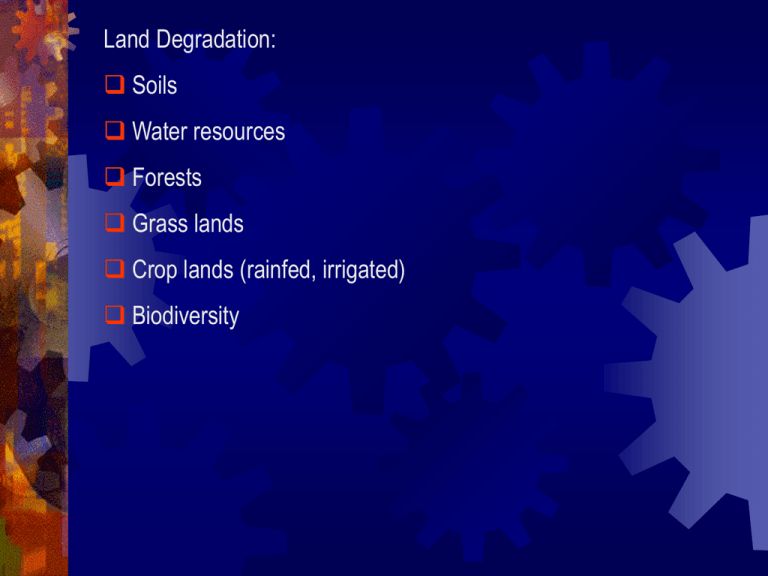
Land Degradation: Soils Water resources Forests Grass lands Crop lands (rainfed, irrigated) Biodiversity CAUSES OF LAND DEGRADATION : Deforestation Overgrazing Agricultural activities Exploitation of vegetation Industrial activities Geographical area of India 3287 lakh ha Net cultivated area : 1420 lakh ha Irrigated area : 570 lakh ha Rainfed area : 850 lakh ha Low productivity and low input usage are two major issues confronting rainfed farming. Productivity per unit of land Productivity per unit of water are important for optimum production. The main agencies for estimation of land degradation are : 1. National Commission on Agriculture 2. Society for promotion of wasteland developments 3. National Remote Sensing Centre 4. Ministry of Agriculture 5. National Bureau of Soil Survey and Land Use and Planning(NBSS&LUP) NBSS&LUP ,Nagpur of ICAR (2005) has reported that India A.P (lakh ha) (lakh ha) a. Water erosion 936.80 115.18 b. Wind erosion 94.80 ----- Water logging/flooding : 143.00 18.96 Salinity/alkalinity : 59.40 5.17 Soil acidity : 160.40 9.05 Complex problems : 73.80 1.56 Geographical area : 3287.00 275.05 Degraded area(%) : 44.66 54.5 Since inception upto 10th Five year plan MINISTRY OF AGRICULTURE Sl.No PROGRAMME AREA (Lakh ha) AMOUNT (Rs crores) 1 NWDPRA (1990-91) 93.09 3025.56 2 RVP&FPR (1962&81) 64.86 2244.24 3 WDPSCA(1974-75) 3.93 295.58 4 RADAS(1985-86) 7.11 121.74 5 WDF(1999-00) 0.59 26.02 6 EAPs 18.15 3967.35 187.73 9680.49 Total Ministry of Rural Development Sl.No PROGRAMME AREA (Lakh ha) AMOUNT (Rs crores) 1 DPAP(1973-74) 137.27 4842.50 2 DDP(1977-78) 78.73 1949.88 3 IWDP(1988-89) 99.56 2438.15 4 EAPs 5.0 292.67 320.56 9523.20 Total Ministry of Environment & Forests Sl.No PROGRAMME AREA (Lakh ha) AMOUNT (Rs crores) 1 NAEP(1989-90) 0.70 47.53 0.70 47.53 Total XI PLAN PROPOSALS MINISTRY OF AGRICULTURE Sl.N o PROGRAMME 1 NWDPRA 15.00 1500 2 RVP&FPR 12.50 1500 3 WDPSCA 2.00 240 4 RADAS 1.00 100 5 WDF 5.00 600 6 EAPs 5.00 750 7 RADP 30.00 3300 70.50 7990 Total AREA (Lakh ha) AMOUNT (Rs crores) Ministry of Rural Development Sl.No PROGRAMME AREA (Lakh ha) AMOUNT (Rs crores) 1 DPAP DDP IWDP 240.00 15358 240.00 15358 2 IWDP/IWMP 3 Total PLANNING COMMISSION Sl.No PROGRAMME 1 AREA (Lakh ha) Hill Area & Westren 10 Ghat Development Programme AMOUNT (Rs crores) 2500 What is watershed Why Watershed Development What is watershed Development COMPONENTS OF WATERSHED DEVELOPMENT Human Resource Development (Community Development) Soil and Land Management Water Management Crop Management Afforestation Pasture / Fodder Development Livestock Management Rural Energy Management Farm and Non-farm value addition activities All these components are interdependent and interactive Why People’s participation Classification of watershed •Hydrologic unit - Size (in ha) Region > 300 lakh - •Basin - 30-300 lakh Catchment - 10-30 lakh Sub catchment - 2-10 lakh Watershed - 50,000-2, 00000 Sub-watershed 10,000-50,000 Milli -watershed 1,000-10,000 Micro watershed 100-1000 Mini watershed - 1-100 WATERSHED MANAGEMENT The watershed management implies the judicious use of all the resources i.e. land, water, vegetation in an area for providing an answer to alleviate drought, moderate floods, prevent soil erosion, improve water availability and increase food, fodder, fuel and fiber on sustained basis. Watershed to achieve maximum production with minimum hazard to the natural resources and for the well being of people. The management should be carried out on the watershed basis. The task of watershed management includes the treatment of land by using most suitable biological and engineering measures in such a manner that, the management work must be economic and socially acceptable PRINCIPLES OF WATERSHED MANAGEMENT The main principles of watershed management based on resource conservation, resource generation and resource utilization are: • Utilizing the land based on its capability • Protecting fertile top soil • Minimizing silting up of tanks, reservoirs and lower fertile lands • Protecting vegetative cover throughout the year • In situ conservation of rain water • Safe diversion of gullies and construction of check dams for in creasing ground water recharge • In creasing cropping intensity through inter and sequence cropping. • Alternate land use systems for efficient use of marginal lands. • Maximizing farm income through agricultural related activities such as dairy, poultry, sheep, and goat forming. • Improving infrastructural facilities for storage, transport and agricultural marketing, •Water harvesting for supplemental irrigation. • Improving socio - economic status of farmers OBJECTIVES OF WATERSHED MANAGEMENT •The term watershed management is nearly synonymous with soil and water conservation with the difference that emphasis is on flood protection and sediment control besides maximizing crop production. •The basic objective of watershed management is thus is thus meeting the problems of land and water use, not in terms of any one resource but on the basis that all the resources are interdependent and must, therefore, be considered together. •Adequate water supply for domestic, agricultural and industrial needs. • Abatement of organic, inorganic and soil pollution, • Efficient use of natural resources for improving agriculture and allied occupation so as to improve socio-economic conditions of the local residents, and • Expansion of recreation facilities such as picnic and camping sites. •The watershed aims, ultimately, at improving standards of living of common people in the basin by increasing their earning capacity, by offering facilities such as electricity, drinking water, irrigation water, freedom from fears of floods, droughts etc. •The overall objectives of watershed development programmers may be outlined as: •Recognition of watersheds as a unit for development and efficient use of land according their land capabilities for production, •Flood control through small multipurpose reservoirs and other water storage structures at the head water of streams and in problem areas, STREAM ORDER ORDER NO.OF SEGMENTS BI-FURCATION RATIO 1 10 2 3 3.3 3 1 3.0 Drainage density is a measure of the length of stream channel per unit area of drainage basin. Mathematically it is expressed as: Drainage Density (Dd) = Stream Length / Basin Area The measurement of drainage density provides a hydrologist or geomorphologist with a useful numerical measure of landscape dissection and runoff potential. On a highly permeable landscape, with small potential for runoff, drainage densities are sometimes less than 1 kilometer per square kilometer. On highly dissected surfaces densities of over 500 kilometers per square kilometer are often reported. Closer investigations of the processes responsible for drainage density variation have discovered that a number of factors collectively influence stream density. These factors include climate, topography, soil infiltration capacity, vegetation, and geology. SPLASH EROSION SHEET EROSION GULLY EROSION 1. DROUGHT PRONE AREA PROGRAMME (DPAP): Objective of the scheme: This is a centrally sponsored scheme funded by Centre and State on the ratio 50:50 basis up to IV batch i.e., 1998-99 and 75:25 basis from Vth batch i.e., 1999-2000 onwards. The period and cost of the project per each watershed was four years and Rs. 20.00 lakhs up to IV th batch. It is five years and Rs. 30.00 lakhs from V th batch onwards. It is aimed to develop the drought prone area with an objective of drought proofing by taking up of insitu soil / land moisture conservation, water harvesting structures, afforestation and Horticulture programmes on a comprehensive micro watershed under ridge to valley concept basis. So far 4242 number of watersheds have been taken up covering an area of 21.21 lakh hectares in 11 districts with 94 blocks. So far 1608 watersheds have been completed and treated an area of 8.04 lakh ha. Strategy of implementation: Developing waste lands / degraded lands on watershed basis. Overall economic development of resource poor. For Mitigation of drought, Employment generation and Poverty alleviation Scheme is being implemented by User groups, Self-help groups, through watershed committees under supervision of PIAs. Sharing Pattern (CSS): 50:50 up to IV th batch, 75:25 from Vth batch onwards. DESERT DEVELOPMENT PROGRAMME (DDP) Objective of the scheme: This is a centrally sponsored scheme funded by Centre and State on the ratio 75:25 basis. It is aimed to develop the drought prone area with an objective of drought proofing by taking up of soil land moisture conservation,water harvesting structures, afforestation and Horticulture programmes on a comprehensive micro watershed under ridge to valley concept. So far 1054 watersheds were taken up covering an area of 5.27 lakh hectares in Anantapur district in all 16 blocks. So far 206 watersheds have been completed , treated an area of 1.03 lakh ha. Strategy of implementation: Developing waste lands / degraded lands on watershed basis. Overall economic development of resource poor. For Mitigation of drought. Employment generation and poverty alleviation. The period and cost of the project for each Watershed was four years and Rs.22.50 lakhs respectively up to V th batch. It is five years and Rs. 30.00 lakhs from VI th batch on wards INTEGRATED WASTE LAND DEVELOPMENT PROGRAMME (IWDP) Objective of the scheme: Rapid depletion of green cover and vast stretches of marginal lands lying fallow, found to be causing enormous ecological imbalance. Productivity is also negligent on account of soil erosion and marginalization of lands. To arrest this, massive integrated wasteland development project was under taken during 1991 with 100% central assistance. The programme of dry land development in Andhra Pradesh. underwent a major change from 1995-96 with the introduction of new watershed guidelines prepared by Sri Ch.Hanumantha Rao. The Scheme is being implemented in 19 districts in A.P. in non- DPAP blocks of DPAP districts and in all non-DPAP districts, with 1638 (114 Projects) Watersheds covering an area of 8.02 Lakh hect. The objective of the projects is to enable “Government of AP for checking of land degradation ,sustainable and increased productivity of land based on watershed concept”. INDIRA PRABHA (Comprehensive Land Development Project ) Objective of the scheme: The main objective of the scheme is to provide an Integrated and Comprehensive Livelihood options centered on Development of compact blocks of assigned lands owned by the poor to ensure these lands become productive assets for the poor. Government have sanctioned 1725 projects blocks under RIDF-IX, X and XIII Projects with financial outlay of Rs.599.00 crores in 22 districts to develop 5.51 lakh acres of assigned land belonging to 3.67 lakh families of SC,ST,BC and others. It is proposed to complete the project in 3 years of administrative sanction. WATERSHED PROGRAMMES IN A.P NRM (A) SMC Works (i) Earthen bunding (ii) Pebble bunding (iii) GC works (iv) Sunken pits in gullies (v) CCT/Staggered trenches (B) WH Works (i) Farm ponds (ii) Mini PTs (iii) Gabion structures (iv)Percolation tanks (v) Check dams (vi) Diversion drains (vii) Feeder channels (viii) Repairs to old tanks and kuntas (ix) Desilting of tanks (x) Recharging drinking water sources (C) Plantation works (i) Block plantation (ii) Avenue plantation (iii) Institutional and household planting (iv) Bund and Boundary planting (v) Horticulture (vi) Pasture Productivity Enhancement: Adaptive trials and infrastructure –Revolving fund Entreprise promotion : Revolving fund

